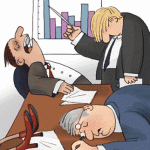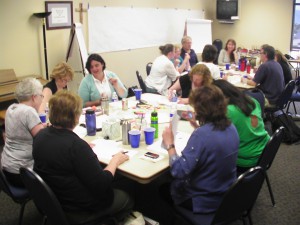.
As seen on Twitter:
“Hi. I’m in a staff meeting. There are 83 ceiling tiles in our meeting room. And 8 light fixtures, with 24 fluorescent bulbs. That is all.” It must have been an awesome meeting…
I’m sure nearly all of us can relate to enduring a meeting like it at some point. “So — how many ceiling tiles in your conference room?” Some of you know the answer…

Another question: how many times have you sat in a meeting feeling frustrated, anxious, irritated — and pleading silently for the person in charge of the meeting to run the dang meeting for goodness’ sake? Or worse yet, you (and everyone else in the room, you can be assured) question the reason the meeting got called in the first place.
Knowing when and how to call a meeting, and then effectively running the meeting, are two of the most important skills a good leader can possess.
Unfortunately, most leaders were absent during the class in which meeting skills were taught. Instead, they rely upon their positional leadership to be enough. “Because I said so!” doesn’t work with parents, and it is even less effective for leaders.
.
The Worst Meeting Leader in the History of the World
While it took some thinking on my part, I was able to put one person in the category of “worst meeting leader in the history of the world.”
This person was so self-absorbed that he wouldn’t even attend his own meetings on a regular basis. Most of the time, he would send some ineffectual underling to express his perspectives and positions — without, of course, empowering them with the ability to say yes to anything. If he did grace us with his presence, he’d spend the majority of the meeting staring at his iPad, answering his seemingly endless stream of e-mails. He’d claim to be listening and would even occasionally growl some disagreement to a point being made.
In general, he gave everyone the impression that he was just too good for the meeting — and for the people attending it.
Here’s a “playbook” I’ve developed based upon my experience with him (and other terrible meetings leaders) to ensure crummy meeting outcomes:
1. No agenda, or the agenda appears only at the beginning of the meeting, or worse yet, the “leader” of the meeting keeps the agenda to him or herself, referring to it by themselves, keeping it from everyone else.
2. Vague or unknown purpose for the meeting.
3. Even if it is a standing meeting (like steering committees or staff meetings), the process and content of the meeting changes, is random, or is predictably unpredictable.
4. Because there are no advance materials, including no list of attendees, no one has a clue about who will be there and what the political ramifications and characteristics will be.
5. Frustration, cynicism, protectionism, and positioning are common. In a vacuum (particularly related to personal power), people will almost always make negative assumptions.
6. Random meeting leadership (oh, whichever executive happens to be there).
7. Meetings starting late, running late, speakers unprepared, no coordination related to content or look and feel, and on and on.
Back to the “Worst Meeting Leader in the World…”
By using this playbook, while he (I believe) felt like he was being the big, bad boss, most people despised him and looked for every opportunity to secretly sabotage him. He was a joke, and he didn’t know it. Now, that’s really sad. He probably still doesn’t know it, as he’s still working his “meeting magic” for a large company based here in Denver.
.
The “Rare” Species: A GREAT Meeting Leader
Unfortunately, I have few examples in my past of exceptionally good meeting leaders. I’ve built some cynicism surrounding meetings in general, and like most of us (I believe), I keep my expectations low so I don’t become disappointed when the normally poor meeting dynamics manifest themselves. Every now and then, I’m pleasantly surprised when someone actually runs a good meeting. I always take the time and effort to thank the leaders of these meetings, and almost always, these leaders are surprised to have been recognized.
Due to too many bad experiences with poorly run meetings, I think many of us have become cynical about meetings overall. As a result, through Neural Linguistic Programming (NLP, something Dr. Pavlov studied in detail through his work with sounds, dogs, and food), we often have a Pavlovian response to a memo announcing a meeting.
“Oh, great. Another waste of time.”
To reinforce this point, there’s a quote that I like: “People Who Enjoy Meetings Should Not Be In Charge Of Anything. — Thomas Sowell. Now, I think Thomas was a cynic, but many people share this attitude.
Meetings are useless, right?
I take a different view: I believe meetings can be informative, energizing, catalyzing, and motivating! Yes, I do. In fact, we’ve all attended meetings where we felt all these things, and I’ll bet you were surprised when that happened.
.
16 Secrets to Calling and Running a Great Meeting

A GREAT meeting in progress!
1. Have a clear agenda, and publish it in advance.
2. Have a known purpose for the meeting.
If it is a standing meeting (like steering committees or staff meetings), have specific objectives for each meeting. Keep the overall agenda and process for standing meetings somewhat similar.
Understand that attendees want to know what to expect! If the meeting is for information sharing, not brainstorming, limit the Q and A in advance.
If the meeting is for teambuilding and interpersonal sharing, do not set unreasonably firm or short time frames for meeting sections. Meetings of this kind need to evolve, and facilitators need flexibility.
3. Set the “political tone” for the meeting as part of the agenda and advance materials.
4. Give a complete list of attendees to all attendees, including those persons who may or may not be able to attend part or all of the meeting.
5. Don’t hide content related to organizational realignment or restructuring.
If the meeting is to announce something of this kind, give as much advance notice and information about this as possible. In a vacuum, people do not assume good news.
6. Appoint one person as facilitator.
It may not be the most senior person in the room. The facilitator needs to have the clear authority of the most senior person, however, even if that person is not in the room!
7. Start the meeting on time.
Start on time even if everyone is not in the room. You need to establish this from the start; otherwise, just like kids, the participants will stretch the authority of the facilitator.
8. Resume the meeting on time following breaks.
9. Clearly communicate the expectations of the meeting at the start of the meeting Including roles, responsibilities, and participation of each attendee.
10. Allow only rare interruptions during the meeting. Get rid of all distractions: cell phones, laptops, iPads, Blackberries, etc.
11. Have a short, focused meeting rather than one that drags along due to interruptions.
12. Make sure participants (speakers) are well prepared.
This includes: Dovetailing of messages, consistency of terms, similar look and feel to presentation materials (if part of the meeting), time frames that are to be respected
13. Run sections of the meeting close to schedule, and handle any deviation in published time frames as they arrive.
14. Communicate dynamic schedule changes throughout the meeting, along with implications related to changes in ending times. Understand that busy people are over-scheduled and as such are always mentally readjusting their time commitments.
15. Summarize the meeting content at the end.
• Note action items.
• Share personal responsibilities and reach agreement.
• Make clear the time frames, deadlines, and so on.
• Set dates and times for any additional meetings.
16. Prepare minutes shortly after the meeting, and circulate them among the attendees.
This is particularly important for policy-related meetings.
Everyone “hears” things differently, even with excellent facilitation and summarized content at the end of the meeting.
Minutes give attendees a chance to “hear the same thing, the same way” or to give feedback about the interpretation of the meeting content reflected in the minutes.
Allow attendees the chance to offer input and feedback about the minutes.
.
SPECIAL NOTE: Avoid Blinding BS
It’s all too common in some professions (IT, engineering, medicine, law, etc.) for meetings to be perceived negatively. Why? Because by nature, most real business people have biases and misconceptions of what an these kinds of meeting might be like.
Too often, they believe the meeting will be full of techie-talk and jargon. (Okay, I’m generalizing here — only “some” rely heavily on jargon and “blinding BS” to communicate. However, we must ALL make a pact right now to stop that. Stop that. It doesn’t make you look authoritative and intelligent; it makes you look annoying and conceited. Stop that!)
And, if the meeting is jammed with techie-talk or jargon, most real people either feel their participation is not necessary or that they will be forced to look stupid because they can’t participate effectively. Either way, it’s not a good thing for the leader.
So, my overall advice related to effective communication is that we need to be extra careful to make sure we do not include buzzwords, acronyms, or jargon that the average person (I am thinking my aunt and uncle here) would understand immediately. Never assume anyone knows what something means. Bad form for sure, and debilitating, too, for leaders who want to be more effective at communication.
.
Be Rare. Call and Run GREAT Meetings!
Want to stand out in the crowd? If you follow the rules for good meetings regularly and religiously, your “followers” will begin to look to you as a consistent, reliable, and respected/respectful leader. On the other hand, if you do not run good meetings, your credibility as a leader suffers dramatically (even if you are a good person otherwise).
Effectively calling and running meetings gives real leaders the chance to demonstrate their skills and to reinforce their ability to lead. If nowhere else, new or emerging leaders — through their ability to run effective meetings — have the chance to grow themselves and to increase their sphere of influence as professionals.
(The content of this post has been adapted from chapter 8 in “Untangling IT: 25 Years of Lessons in Effective IT Leadership,” © 2003, Robert S. Tipton.)




2 Responses to ““Great Meeting” is Not an Oxymoron”